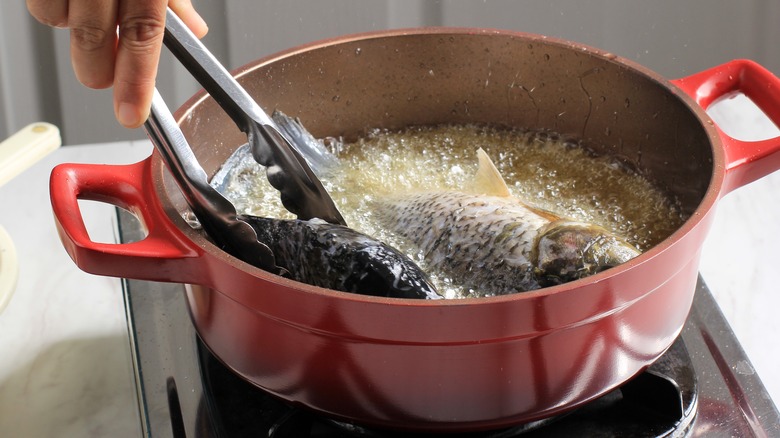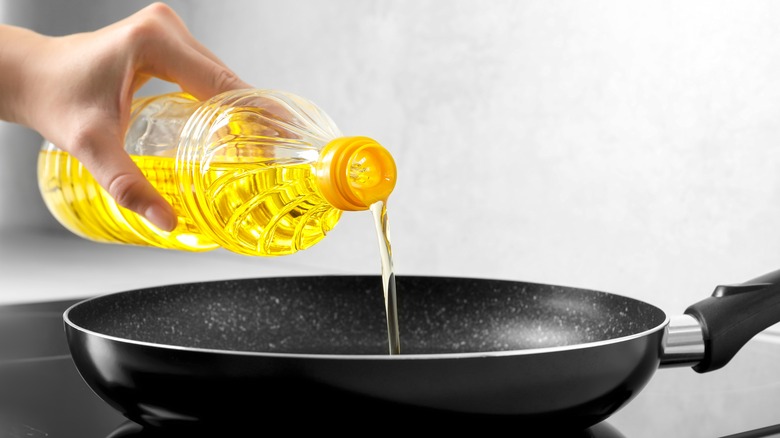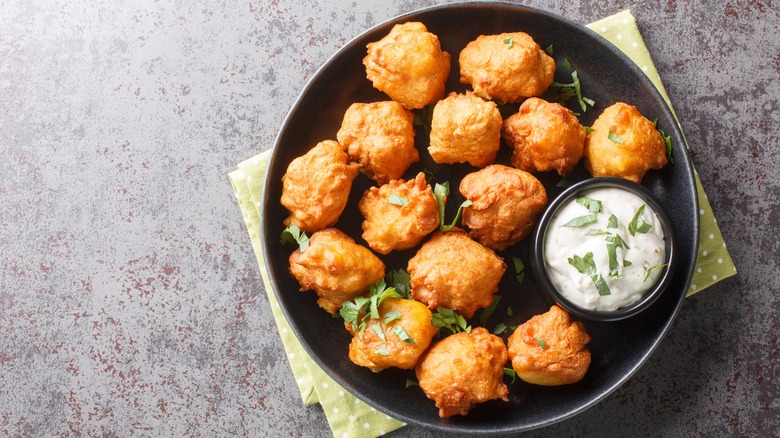The Right Way To Reuse Oil After Deep Frying Fish
In a world where individuals have learned the beauty of deep frying food and have clung onto it ever since the second millennium BCE, we can thank hot oil for bringing us the classics we've treated ourselves to throughout the years, from donuts and shrimp tempura to beignets and onion rings. Then there are our more complex, lavish spreads that also require fried elements like a baja fish taco bowl or crispy breaded chicken katsu. With the list of beloved fried foods continuing on with no end in sight, it's not surprising to learn that people have discovered ways to reuse oil from one dish to the next. It's cost-effective and can be done so long as your oil is still in good condition, which you can gauge through its color, taste, and odor.
The real question lies in how to correctly go about this process. More specifically, what's the right way to reuse oil after using it to deep fry particularly potent ingredients, such as fish? Utilizing the same vat of oil more than once, including those that have been used to heat seafood, is a commonly used method even in restaurants. But if you want to take advantage of this money-saving hack without having every subsequent dish taste like the tilapia or cod you fried for last week's dinner, it's worth learning the proper steps and suggested follow-up meals for reusing your oil.
How to safely prepare oil to be reused
First determine if your oil is still fit to be saved, which can be done by seeing if it has become clouded, foamy, or drastically different in consistency and smell. If it doesn't pass the test, use one of the many reasonable ways to dispose of cooking oil, whether that's using it as a paint remover or to condition old leather. Otherwise, if it's able to be salvaged, the next step is to let it fully cool down.
Once you're able to safely and comfortably work with the oil, you can then move on to filtering it. This is done by straining the liquid with a cheesecloth, coffee filter, or fine mesh strainer that will help separate any leftover particles that may have come off your fish. The oil will further take on the fishy, oceanic taste if you don't take the time to refine it of any unwanted particles. Catch the clean oil with an airtight container, such as the original packaging or a glass jar. Use a funnel if necessary.
And because this oil was used for a rather strong, dominant food like fish, it's best to label it so you know to use it for similar dishes in the future. Now your oil will be almost as good as new and ready for the next deep frying session. Just store it in a cool, dark place until then.
Dishes to incorporate oil previously used for frying fish
While thoroughly filtering leftover remnants from your used oil will help rid it of any excessively unwanted flavor, it's impossible to completely wipe out every trace of your last ingredients, especially if it was fish. Fish tends to overwhelm the senses and may leave behind a rather distinct aroma and taste. So unless you're making something that pairs well with seafood and don't mind the risk of it tasting a bit like the ocean, it's recommended to use your old oil for frying another fish. And if that oil happens to be vegetable or canola, you're already a step ahead, as these are the best kinds of oils to use for just that.
This is the time to follow up with a classic British fish and chips recipe, some coconut shrimp, or perhaps some fried fish tacos. Even if not fish-based, other savory meals will hold up better when utilizing your saved oil as opposed to sweet treat recipes for deep fried Oreos or funnel cake. A hint of fishiness can go a long way in helping enhance the flavor of your Cajun andouille hush puppies recipe, for example.


